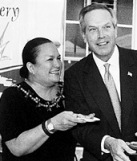Blog
News, updates, finds, stories, and tidbits from staff and community members at KAHEA. Got something to share? Email us at: kahea-alliance@hawaii.rr.com.
Kitty: Here's a mirror
 If Kitty Simonds (WESPAC Exec.) really believes what she wrote in this Sunday-Editorial, then this woman needs to take a good look in the mirror. She calls out the U.S. military for the harm its presence causes the people of the Pacific, when WESPAC’s own mismanagement over the last 25 years has decimated multiple fisheries here.
If Kitty Simonds (WESPAC Exec.) really believes what she wrote in this Sunday-Editorial, then this woman needs to take a good look in the mirror. She calls out the U.S. military for the harm its presence causes the people of the Pacific, when WESPAC’s own mismanagement over the last 25 years has decimated multiple fisheries here.
Yes, the U.S. military should not be stationing troops and conducting exercises in the fragile and important waters surrounding these island-nations. At the same time, WESPAC should not be tyring to exploit their resources for U.S. commercial extraction either.
WESPAC and the U.S. military: they are the left and right boots of the U.S. empiral march over the people of the Pacific.
That said, I had to laugh reading this. It is just so ironic to hear Kitty of all people advocating for more transparency and public participation in the decision-making process. (Someone please launch the pigs.)
WESPAC has been one of the worst offenders when it comes to open government. Not only is WESPAC under investigation by two federal agencies for misuse of federal funds, but we and few other groups just filed suit against them for failing to release government records under the Freedom of Information Act (FOIA).
Adding to the irony of Kitty’s argument here: there were public hearings held on the designation of additional marine monuments throughout the Pacific. I attended the one in Honolulu myself. It was conveniently located just down the block from WESPAC’s annual 3-day meeting. Unfortunately, I didn’t see any of the WESPAC representatives at that public hearing on the monuments.
Marine monuments shouldn’t have higher priority than people
By Kitty Simonds
Honolulu Star-Bulletin
January 18, 2009WestPac – The Western Pacific Regional Fishery Management Council – appreciates the Bush administration’s recognition that the newly proclaimed U.S. Pacific island marine monument waters have been “effectively regulated under the Magnuson-Stevens Act and by WestPac.” These new national monuments “are complementary strategies” to the fisheries management plans developed by the council, noted Jim Connaughton, chairman of the White House’s Council on Environmental Quality.
Under the council’s plans, a ban on all fishing from 0 to 50 fathoms (300 feet) depth has been in effect since 2004 in all of the areas. Coral reefs do not live below this depth. Pelagic fishing by vessels larger than 50 feet in length has been banned within 50 miles of the Rose Atoll wildlife refuge in American Samoa since 2002. Under the U.S. Fish & Wildlife Service National Wildlife Refuge status, commercial fishing has been banned within 12 miles of Palmyra since 2001.
The council looks forward to continuing its work to protect everyone’s interest in these areas.
However, it is concerned that the Antiquities Act, used to create these enormous marine monuments, currently bypasses the National Environmental Policy Act, which mandates an environmental review as well as an appropriate participatory process for the indigenous people and other members of the public. The Antiquities Act should be amended to require NEPA as well as congressional approval of future monuments, as it does in Wyoming and Alaska.
The U.S. Pacific Islands now account for half of the marine protected areas in the United States. Local commercial fishermen are banned from nearly a quarter of the waters surrounding the U.S. Pacific islands. The significant loss of fishing areas can be counterproductive to sustainable fishery goals. Reduction of available fishing areas often leads to increased fishing pressure in other areas. It also undermines cultural and ecological goals. Our populations consume three times the national average in seafood and should be able to eat their own fish. When local fisheries are closed, the consequence is air-freighting imported fresh fish, which has negative effects on climate change and ocean acidification by increasing the U.S. carbon footprint. The U.S. currently imports 86 percent of its seafood.
While well-regulated and monitored commercial fishing with no proven negative ecosystem effects are being banned, other activities that can harm the monument resources will be allowed. Military activities will continue and are expected to increase with the relocation of 8,000 Marines, plus their families, and 15,000 contract workers to Guam.
Military bombing in nearby Farallon de Medinilla in the Commonwealth of the Northern Mariana Islands is allowed to kill all the endangered megapodes (a flightless bird) on the island, under a Fish & Wildlife Service-issued biological opinion. Hawksbill, green and leatherback sea turtles, fruit bats and other plant and animal species are also affected by the bombing and other military activities.
The Bush administration has compared the new monuments to the Northwestern Hawaiian Islands, where monument designation has led to increased human activity from tourists, visitors and researchers. While traditional indigenous fishing is permitted, the fish must be consumed within the monument and cannot be brought back to family and communities.
The only way to realize the president’s dream for the new monuments is through much-needed funds to the U.S. Coast Guard and local government agencies to adequately patrol and enforce the waters surrounding the U.S. Pacific islands. The Marianas’ waters are within 1,500 to 2,000 miles of the Asian mainland and Southeast Asia and could be accessed by every major Asian fishing fleet.
We look forward to the promised economic bounty that the Marianas and American Samoa communities will receive from the monument designation, but hopefully, if it comes, it will not be at the expense of the environment or the indigenous people. Kitty Simonds is executive director of the Western Pacific Regional Fishery Management Council.





